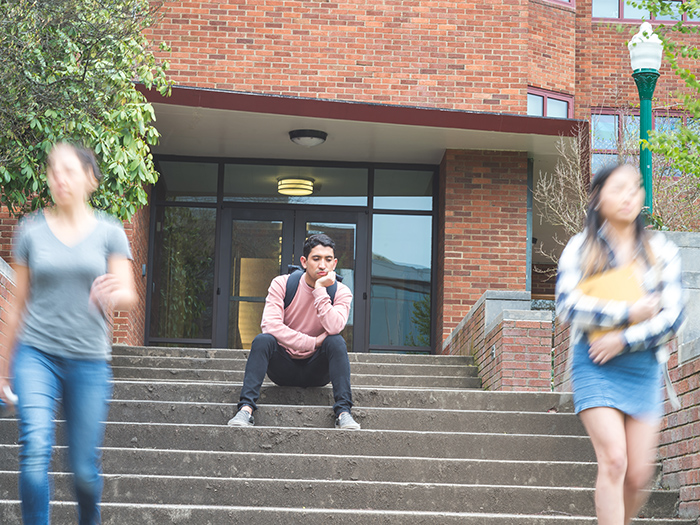The List of Social Stressors College Students Can Face Is Endless. Meet the People Stepping Up to Help

Mental health is not a topic to shy away from; it’s a discussion that is necessary to be had.
Within the higher education realm, the need to address student mental health has never been clearer, as seen in the American College Health Association’s 2022 survey of 54,000 undergrads — 77% of which stated they were experiencing moderate to serious psychological distress.
Mental health hurdles span across the entire higher education experience, from deciding on a major to the stressors brought on by student athletics and more. That’s why Risk & Insurance is devoting this series to uncovering the mental health struggles students face daily and how insurance can play a role in helping universities and colleges manage the risks.
In this installment, we look at student mental health through the lens of social life, examining which stressors contribute to mental health setbacks, and how universities can best employ services to aid students.
The Stressors of Social Life
It’s important to note that no student is immune from the potential setbacks social life stress can produce.
“While there are many commonalities across students’ mental health stressors and social stressors, the stage of the student’s life plays a role. It’s important not to ignore the commuter students, the parents, the older students, the grad students, and other groups of nontraditional students,” said Justin Kollinger, senior risk management consultant of United Educators.
Kollinger went on to list several issues that can contribute to a struggling student’s social life, from relationship problems, loneliness, family and friend relationships, and sexual assault.
“There are a lot of different ways that this can arise across different students,” he said.
Some universities have taken it upon themselves to identify stressors that students could potentially experience throughout the college experience: increased responsibilities, lack of time management skills, and lack of self-care, to name a few.
Kollinger did emphasize that social challenges should be viewed separately from mental health challenges, though one could be a catalyst for the other. He used the example of a student who is already suffering from a mental health condition while also experiencing a lack of social connection or isolation.
“When you’re combining depression, anxiety, or other mental health conditions, with a lack of social connection, you might not find relief in turning to friends or trusted confidants,” Kollinger explained.
The Pandemic Angle
With the above stressors already present for the higher ed population, the introduction of the pandemic not only amplified the current stressors but presented new ones.
The social development of humans is still active and prospering during the years in which a person is in college. However, because of the social distancing guidelines brought on by the pandemic, these critical years of social development were interrupted for current students.
“Some of the social development that we do as humans continues into our 20s, well after high school and middle school. And the pandemic left a big gap,” Kollinger said.
He continued, “There are a lot of skills, like the ability to understand and develop your own self identity, your own personal understanding of yourself in relation to others” that were disrupted in the wake of the pandemic. These issues were prevalent when social distancing restrictions eased, and students returned to their college campuses. For many students, they were experiencing life on a college campus for the first time.
“Social skills, like the ability to make friends or develop healthy relationships, are skills that need practice. And without practice, students excitedly come to a new campus environment or return to a campus, but maybe not as prepared as they thought, ” Kollinger said. “That has an impact on a student’s mental health.”
Specifically, tensions spiked between students emerging from isolation, and institutions noted a drop in their abilities to “resolve conflicts” and their lack of “conflict resolution skills,” per Kollinger. A student affairs team that Kollinger had spoken with noted this rise in conflict as a difference in academic and social resilience.
“Academically, students are reverting back to where they were before the pandemic,” Kollinger said. “But that has not happened the same way on the social relationship side.”
How Universities Are Stepping Up
Student mental health challenges were already a relevant concern for universities to address, but the pandemic made them abundantly clear.
Kollinger said that one major way universities are providing support for students is by incorporating policies and procedures that focus on mental wellbeing. Some universities are now opening the accommodations process for students suffering from mental health challenges.
“When we think about the accommodations process for students, they [typically] seek them for learning,” Kollinger said. “But those policies haven’t always been written with mental health conditions in mind.”
Now, “institutions have been clarifying those accommodations processes and procedures to make sure that students are getting the accommodations they’re qualified for” when it comes to mental health, according to Kollinger.
He said, “Mental health conditions certainly fall under that umbrella of disability, and institutions are getting better at managing that.”
Universities have also improved their offerings for student mental health, including the use of telehealth services.
Elizabeth Marks, senior strategy consultant at Academic HealthPlans, Risk Strategies’ student health practice, discussed the benefits of incorporating a telehealth approach to universities, especially because of the difficulties linked to securing on-campus therapists.
“Because of the demand and the lack of resources, telehealth has surged in terms of utilization,” she said. And, according to research from Risk Strategies, 62% of the students that are using telehealth are doing so to address a behavioral health issue, rather than using it for urgent care when a physical injury arises.
Marks also noted Risk Strategies data shows 47% of students who used telehealth to talk to a counselor only used the service for one visit, indicating that those students didn’t need ongoing therapy but rather just someone to talk to.
Other methods that universities can implement help for students include a 24/7 crisis hotline.
Kollinger also mentioned different ways universities have served their students in the wake of a counselor shortage.
“We’ve seen some [universities] get creative,” he said. As noted before, students may not have progressed as they typically would have socially as a result of the pandemic. Kollinger said some universities have begun the implementation of apps and programs “to help focus on extracurricular social skill development, like making new friends and building deeper relationships.”
Additionally, to address the issues that come with self-identity, universities have established what Kollinger referred to as “identity-focused resource centers.” These include women’s health center, multicultural centers, and LGBTQ+ centers.
The Link Between Academic and Social Success
Although it’s the consensus that academic success should be prioritized over the successes of a happy social life, the two are closely intertwined at the collegiate level. In some ways, their advances hinge on the other.
“Students learn best when they’re healthy and well, so there’s a tight relationship between trying to achieve that academic mission, fostering a healthy social life, and providing growth outside of the classroom,” Kollinger said. &
Stay tuned through our Mental Health in Higher Education Series to read more about how mental health impacts different student demographics across a broad range of topics, like student athletics, social life, finances and more.











